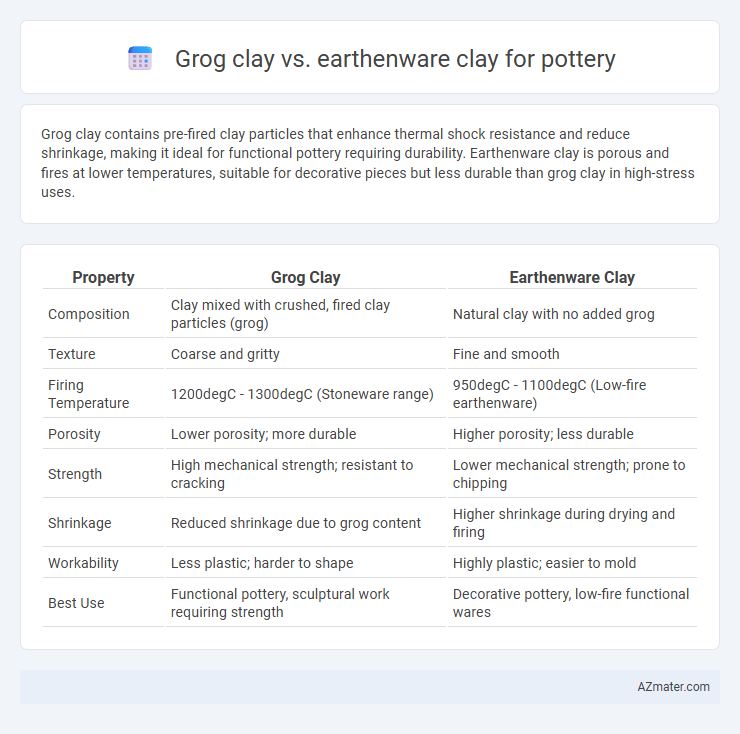Grog clay contains pre-fired clay particles that enhance thermal shock resistance and reduce shrinkage, making it ideal for functional pottery requiring durability. Earthenware clay is porous and fires at lower temperatures, suitable for decorative pieces but less durable than grog clay in high-stress uses.
Table of Comparison
| Property | Grog Clay | Earthenware Clay |
|---|---|---|
| Composition | Clay mixed with crushed, fired clay particles (grog) | Natural clay with no added grog |
| Texture | Coarse and gritty | Fine and smooth |
| Firing Temperature | 1200degC - 1300degC (Stoneware range) | 950degC - 1100degC (Low-fire earthenware) |
| Porosity | Lower porosity; more durable | Higher porosity; less durable |
| Strength | High mechanical strength; resistant to cracking | Lower mechanical strength; prone to chipping |
| Shrinkage | Reduced shrinkage due to grog content | Higher shrinkage during drying and firing |
| Workability | Less plastic; harder to shape | Highly plastic; easier to mold |
| Best Use | Functional pottery, sculptural work requiring strength | Decorative pottery, low-fire functional wares |
Introduction to Grog Clay and Earthenware Clay
Grog clay contains pre-fired ceramic particles that enhance strength, reduce shrinkage, and improve drying time, making it ideal for functional pottery and sculptural works. Earthenware clay is a porous, low-fire clay known for its warm tones and ease of shaping, commonly used for decorative pottery and everyday ceramics. The inclusion of grog in clay bodies increases durability and texture, while earthenware offers a softer, more plastic feel suited for detailed designs.
Composition Differences: Grog vs Earthenware Clay
Grog clay contains pre-fired, crushed ceramic particles that enhance thermal shock resistance and reduce shrinkage during firing, making it ideal for functional pottery and sculpture. Earthenware clay primarily consists of natural clay minerals with higher plasticity but lower firing temperatures and more shrinkage, resulting in a porous and less durable finished product. The key composition difference lies in grog's inclusion of refractory grog particles, which improve structural integrity, whereas earthenware clay lacks these additives, affecting its strength and porosity.
Workability and Texture Comparison
Grog clay contains pre-fired clay particles that enhance workability by reducing shrinkage and increasing strength during firing, making it ideal for creating textured pottery with increased durability. Earthenware clay is finer and more plastic, offering smoother texture and easier manipulation but tends to shrink more and is less heat-resistant after firing. The coarse grit of grog clay provides a rougher surface ideal for sculptural pieces, while earthenware clay's fine particles yield delicate, smooth finishes suited for detailed pottery.
Strength and Durability of Finished Pieces
Grog clay contains pre-fired clay particles that enhance the strength and durability of pottery by reducing shrinkage and preventing cracking during firing and drying. Earthenware clay, typically more porous and less dense, results in finished pieces that are more fragile and less resistant to impact and wear. Potters seeking robust, long-lasting vessels prefer grog clay for its superior structural integrity and resistance to thermal shock.
Firing Temperature Requirements
Grog clay contains pre-fired clay particles that enhance thermal shock resistance and allow for higher firing temperatures, typically ranging from cone 6 (about 2232degF/1222degC) to cone 10 (about 2381degF/1305degC), making it ideal for stoneware and functional pottery. Earthenware clay, with lower firing temperatures generally between cone 06 (about 1828degF/998degC) and cone 04 (about 2167degF/1186degC), maintains porosity unless glazed and is less suitable for high-temperature firing. The thermal properties of grog clay reduce shrinkage and cracking during firing, while earthenware clay requires careful temperature control to prevent warping and maintain durability.
Glaze Compatibility and Surface Finish
Grog clay contains pre-fired clay particles that improve glaze adherence by minimizing shrinkage and reducing surface cracks, resulting in a more durable and textured finish. Earthenware clay, being softer and more porous, requires careful glaze selection to prevent crazing and usually produces a smoother, more porous surface when glazed. Grog clay's coarse texture influences a matte or semi-matte glaze surface, while earthenware clay typically achieves glossy glazes due to its finer particle composition.
Best Uses: When to Choose Grog Clay
Grog clay is ideal for pottery requiring added strength, durability, and resistance to thermal shock, such as functional stoneware, sculptural pieces, and large vessels. Its coarse grog particles improve workability and reduce shrinkage and cracking during drying and firing, making it suitable for intricate or heavy-duty projects. Choose grog clay when creating pottery that must withstand high temperatures, mechanical stress, or frequent handling without sacrificing structural integrity.
Advantages of Earthenware Clay for Potters
Earthenware clay offers superior plasticity and workability, making it ideal for beginners and intricate pottery designs. Its porous nature allows for excellent glaze adhesion and vibrant colors after firing at lower temperatures. Potters benefit from its faster firing cycles and versatility in creating both functional and decorative pieces.
Cost and Availability Considerations
Grog clay typically costs more than standard earthenware clay due to the added grog content, which improves strength and reduces shrinkage but increases production expenses. Earthenware clay is widely available and more affordable, making it a popular choice for beginners and mass production pottery. Availability of grog clay can be limited in some regions, leading to higher shipping costs compared to readily accessible earthenware clay varieties.
Choosing the Right Clay for Your Pottery Project
Grog clay contains pre-fired clay particles that enhance strength, reduce shrinkage, and improve heat resistance, making it ideal for functional pottery like cooking vessels or large sculptures. Earthenware clay, softer and more porous, is better suited for decorative pots and low-fire projects due to its ease of shaping and vibrant glaze adherence. Selecting between grog and earthenware clay depends on the desired durability, firing temperature, and the specific purpose of the pottery piece.

Infographic: Grog clay vs Earthenware clay for Pottery
 azmater.com
azmater.com